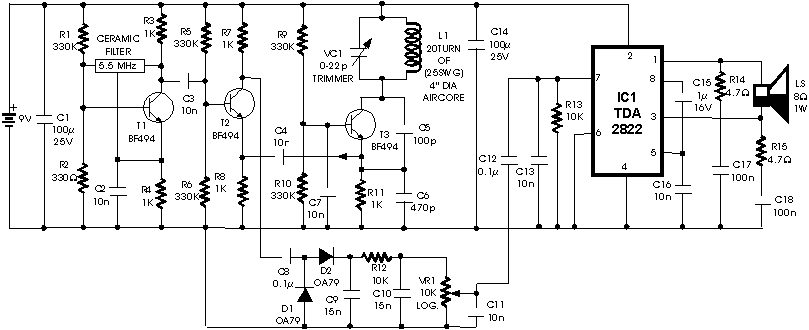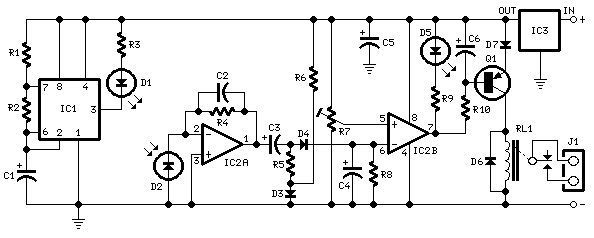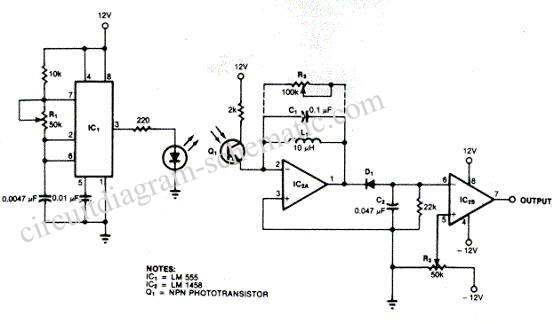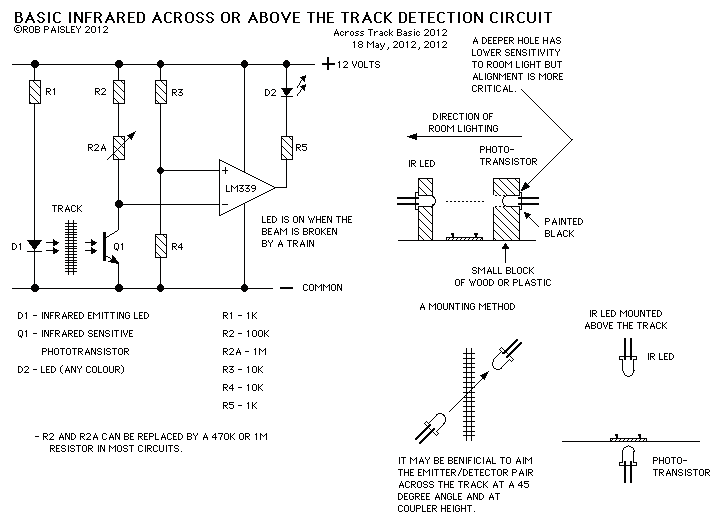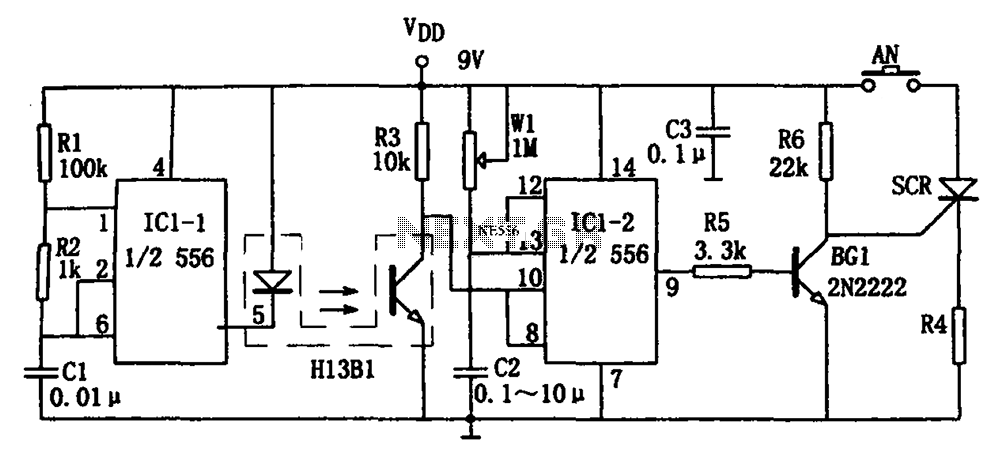
Lightning Detectors
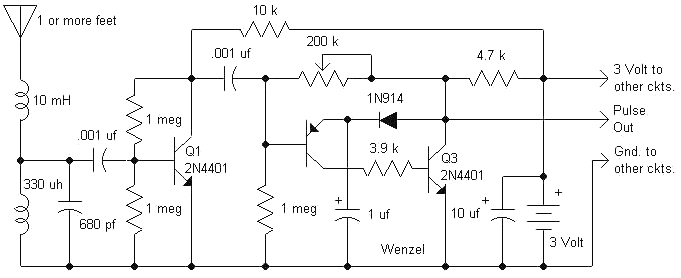
The following circuit is an enhanced version of the original Lightning Detector designed to operate on a 5-volt supply. This updated circuit incorporates a refined RF section with a single resonance near 300 kHz and increased sensitivity. The use of a potentiometer has been eliminated; instead, adjusting the length of the telescopic antenna will achieve the desired sensitivity. The circuit's supply voltage has been raised to 5 volts to facilitate the use of commonly available molded power supplies instead of batteries. An additional feature is the availability of inductors. The basic receiver is depicted below. The antenna is a telescopic type that can extend to two or three feet, with length not being critical. A high-value resistor (270 kΩ) is connected from the antenna to ground to control the Q factor, and this value may be reduced if the circuit appears unstable, although a value that is too low will compromise sensitivity. The 10 mH and 1 mH chokes are molded types, but most moderately high-Q inductors will suffice, and the other components are standard and not particularly critical. The transistors used are all general-purpose types. Note: This circuit is designed for use with one of the lamp options and any or all of the other options. If no lamp is desired, a 1 kΩ resistor should be added from the "pulses" output to 5 VDC. An experimental version is presented with an additional diode across the 82 kΩ resistor, which aids the flasher in triggering on smaller pulses. The 82 kΩ resistor may be replaced with a 100 kΩ if preferred. The antenna, 10 pF capacitor, and two inductors create a resonant tank at approximately 300 kHz, an optimal frequency for capturing energy from lightning. The two series inductors function as a matching network, supplying Q1 with a lower impedance version of the signal received by the antenna. The 270 kΩ resistor reduces the Q of the resonant tank to prevent oscillation. Q1 amplifies the 300 kHz bursts and transmits the amplified signal to the base of a PNP transistor, forming a monostable "flasher" circuit with the final NPN transistor. When the RF signal pulls the PNP base voltage below the voltage on the 10 µF capacitor (plus about 0.6 volts), the PNP activates, which in turn activates the NPN transistor. Since the NPN is connected to the base of the PNP through the 82 kΩ resistor, the PNP turns on more strongly. This regenerative action causes the circuit to activate quickly and fully, pulling the "pulses" line close to zero volts. The circuit remains active until the 10 µF capacitor discharges, at which point a similar reverse regenerative action causes the circuit to turn off rapidly. The capacitor then charges quickly through the 1 kΩ resistor (in one of the lamp circuit options) and the diode, preparing for another pulse. The prototype is housed in a phenolic box using point-to-point wiring. The power switch is a single pole, double throw type with a center-off position. The power supply connects to the center terminal, while the speaker connects to one of the outer terminals. Both outer terminals are also connected to the remaining circuitry via two silicon diodes, one from each terminal. One diode prevents power from reaching the speaker in the "speaker off" position, while the other diode ensures that the circuitry receives the same voltage in both "on" positions. Alternatively, a switch could be added in series with the speaker to disable it. Following a storm, the addition of this switch is recommended if it was not included initially. The diodes can be observed in the close-up of the power switch. Alternatively, a standard single pole, single throw switch could be utilized with another switch in series with the brown wire to disconnect the speaker when the constant crackle becomes bothersome. The basic circuit described above can be combined with any of the following circuits to complete the lightning detector. The prototype utilized the 5-volt lamp driver, meter circuit, and speaker circuit. Any or all of these circuits can be connected as needed.
The lightning detector circuit operates primarily in the RF frequency range, specifically tuned to resonate at approximately 300 kHz, which is effective for detecting electromagnetic signals generated by lightning strikes. The telescopic antenna serves as the primary receiver, capturing these signals and transmitting them to the input of the RF section. The design emphasizes sensitivity and stability, utilizing a high-value resistor to manage the Q factor of the resonant tank formed by the antenna and inductors.
The amplification stage is critical, as it takes weak signals from the antenna and boosts them for further processing. The PNP-NPN transistor configuration creates a regenerative feedback loop that enhances the speed and reliability of the signal detection, ensuring that even brief pulses from distant lightning strikes can trigger the circuit effectively. The inclusion of a capacitor in the feedback loop allows for a quick reset, enabling the circuit to be ready for subsequent signals.
The overall design is modular, allowing for the integration of additional components such as lamps or meters. This flexibility enables users to customize the lightning detector according to their specific requirements. The use of standard components and a straightforward assembly approach makes this circuit accessible for hobbyists and professionals alike, promoting ease of construction and maintenance.The following circuit is an improved version of my original Lightning Detector designed to run on a 5 volt supply. The new circuit features a superior RF section with a single resonance near 300kHz and plenty of sensitivity.
The potentiometer was eliminated; simply adjusting the length of the telescopic antenna will give the desired sensitivity. T he circuit supply voltage was increased to 5 volts to allow the use of commonly available molded power supplies instead of batteries. Another not-so-obvious feature is that I have plenty of the inductors! (For inductors email charles@wenzel. com. ) The basic receiver is shown below. The antenna is a telescopic antenna that extends to two or three feet, the length is not critical. A high-value resistor (270k) is connected from the antenna to ground to control the Q and this value may be lowered if the circuit seems unstable but too low a value will destroy the sensitivity.
The 10 mH and 1 mH ( not uH) chokes are molded types but most moderately high-Q inductors will work fine and the rest of the parts are run-of-the-mill and not particularly critical. The transistors are all general-purpose types. Note: This circuit is intended to be used with one of the lamp options and any or all of the other options.
If no lamp is desired, add a 1 k resistor from the "pulses" output to 5 VDC. Below is an experimental version with an additional diode across the 82k. The diode helps the flasher to trigger on smaller pulses. the 82k may be 100k, if desired. The antenna, 10 pF capacitor, and the two inductors form a resonant tank at about 300 kHz, a good frequency for receiving energy from lightning. The two series inductors act as a matching network, feeding Q1 with a lower impedance version of the signal received by the antenna.
The 270k resistor lowers the Q of the resonant tank to prevent oscillation. Q1 amplifies the 300 kHz bursts and applies the larger signal to the base of a PNP transistor that forms a monostable "flasher" circuit with the last NPN transistor. When the RF signal pulls the PNP base voltage below the voltage on the 10 uF capacitor (plus about 0.
6 volts) the PNP turns on, turning on the NPN. Since the NPN is connected to the base of the PNP through the 82 k resistor, the PNP turns on even harder. This regenerative action causes the circuit to turn on quickly and fully, pulling the "pulses" line to nearly zero volts.
The circuit stays on until the 10 uF capacitor discharges at which point a similar reverse regenerative action causes the circuit to quickly switch off. The capacitor then quickly charges through the 1k resistor (in one of the lamp circuit options) and the diode and is ready for another pulse.
The prototype is built into a phenolic box using point-to-point wiring. The power switch is a single pole, double throw type with a center-off position. The power supply is connected to the center terminal and the speaker is connected to one of the outer terminals. Both of the outer terminals are also connected to the other circuitry through a couple of silicon diodes, one from each terminal.
One diode keeps the speaker from getting power in the `speaker off` position and the other diode is simply there so that the circuitry sees the same voltage in both `on` positions. Alternately, a switch could be added in series with the speaker to turn it off. After one storm, you will add the switch if you don`t include it at first! The diodes can be seen in the close-up of the power switch. Alternately, a ordinary single pole, single throw switch could be used with another switch in series with the brown wire to disconnect the speaker when the constant crackle becomes too annoying!
The basic circuit above is combined with any of the following circuits to complete the lightning detector. The prototype used the 5 volt lamp driver, meter circuit, and speaker circuit. Choose any or all of the above circuits and connect them across 🔗 External reference
The lightning detector circuit operates primarily in the RF frequency range, specifically tuned to resonate at approximately 300 kHz, which is effective for detecting electromagnetic signals generated by lightning strikes. The telescopic antenna serves as the primary receiver, capturing these signals and transmitting them to the input of the RF section. The design emphasizes sensitivity and stability, utilizing a high-value resistor to manage the Q factor of the resonant tank formed by the antenna and inductors.
The amplification stage is critical, as it takes weak signals from the antenna and boosts them for further processing. The PNP-NPN transistor configuration creates a regenerative feedback loop that enhances the speed and reliability of the signal detection, ensuring that even brief pulses from distant lightning strikes can trigger the circuit effectively. The inclusion of a capacitor in the feedback loop allows for a quick reset, enabling the circuit to be ready for subsequent signals.
The overall design is modular, allowing for the integration of additional components such as lamps or meters. This flexibility enables users to customize the lightning detector according to their specific requirements. The use of standard components and a straightforward assembly approach makes this circuit accessible for hobbyists and professionals alike, promoting ease of construction and maintenance.The following circuit is an improved version of my original Lightning Detector designed to run on a 5 volt supply. The new circuit features a superior RF section with a single resonance near 300kHz and plenty of sensitivity.
The potentiometer was eliminated; simply adjusting the length of the telescopic antenna will give the desired sensitivity. T he circuit supply voltage was increased to 5 volts to allow the use of commonly available molded power supplies instead of batteries. Another not-so-obvious feature is that I have plenty of the inductors! (For inductors email charles@wenzel. com. ) The basic receiver is shown below. The antenna is a telescopic antenna that extends to two or three feet, the length is not critical. A high-value resistor (270k) is connected from the antenna to ground to control the Q and this value may be lowered if the circuit seems unstable but too low a value will destroy the sensitivity.
The 10 mH and 1 mH ( not uH) chokes are molded types but most moderately high-Q inductors will work fine and the rest of the parts are run-of-the-mill and not particularly critical. The transistors are all general-purpose types. Note: This circuit is intended to be used with one of the lamp options and any or all of the other options.
If no lamp is desired, add a 1 k resistor from the "pulses" output to 5 VDC. Below is an experimental version with an additional diode across the 82k. The diode helps the flasher to trigger on smaller pulses. the 82k may be 100k, if desired. The antenna, 10 pF capacitor, and the two inductors form a resonant tank at about 300 kHz, a good frequency for receiving energy from lightning. The two series inductors act as a matching network, feeding Q1 with a lower impedance version of the signal received by the antenna.
The 270k resistor lowers the Q of the resonant tank to prevent oscillation. Q1 amplifies the 300 kHz bursts and applies the larger signal to the base of a PNP transistor that forms a monostable "flasher" circuit with the last NPN transistor. When the RF signal pulls the PNP base voltage below the voltage on the 10 uF capacitor (plus about 0.
6 volts) the PNP turns on, turning on the NPN. Since the NPN is connected to the base of the PNP through the 82 k resistor, the PNP turns on even harder. This regenerative action causes the circuit to turn on quickly and fully, pulling the "pulses" line to nearly zero volts.
The circuit stays on until the 10 uF capacitor discharges at which point a similar reverse regenerative action causes the circuit to quickly switch off. The capacitor then quickly charges through the 1k resistor (in one of the lamp circuit options) and the diode and is ready for another pulse.
The prototype is built into a phenolic box using point-to-point wiring. The power switch is a single pole, double throw type with a center-off position. The power supply is connected to the center terminal and the speaker is connected to one of the outer terminals. Both of the outer terminals are also connected to the other circuitry through a couple of silicon diodes, one from each terminal.
One diode keeps the speaker from getting power in the `speaker off` position and the other diode is simply there so that the circuitry sees the same voltage in both `on` positions. Alternately, a switch could be added in series with the speaker to turn it off. After one storm, you will add the switch if you don`t include it at first! The diodes can be seen in the close-up of the power switch. Alternately, a ordinary single pole, single throw switch could be used with another switch in series with the brown wire to disconnect the speaker when the constant crackle becomes too annoying!
The basic circuit above is combined with any of the following circuits to complete the lightning detector. The prototype used the 5 volt lamp driver, meter circuit, and speaker circuit. Choose any or all of the above circuits and connect them across 🔗 External reference
